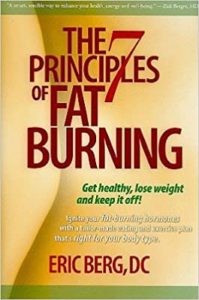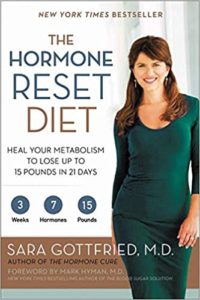Combine discipline with self-love. Granted, you need the discipline to drag yourself out of bed for that early morning exercise class. However, the stronger your self-love and respect, the more you’ll see that discipline as one route to realizing your dreams.
Disclaimer: This post contains affiliate links. Should you make a purchase through one of the links, I may earn a small commission, at no additional cost to you. Know that I stand behind all the products I promote.
Weight gain is one of the most common complaints during menopause. On average, women gain 2 to 5 pounds during the perimenopausal transition (the years leading up to menopause). While this doesn’t sound like a lot, 4 or 4 pounds of body fat can be very noticeable.
Additionally, during menopause, women store fat in their midsection. This fact poses the biggest threat to metabolic health because it increases the risk of heart and blood vessel disease and type 2 diabetes.
If you are troubled by menopause belly fat, your entire life can be affected.
“Apparently, wisdom isn’t the only thing we gain as we age; we gain additional inches around our waist too. During menopause, our body’s adipocytes or fat cells store more fat due to hormonal changes. To make matters worse, the area where our body stores the most fat changes from our hips and thighs to our torso. (Apparently, there’s even a term for it: “muffin top” or “spare tire”). Additionally, you also lose muscle mass with age. It’s a bitter reality to accept, but our body really does change rapidly during menopause.” From the article, Menopause Arrives with Your Waist in Its Sights-Connecticut Hormone Therapy
This quote summarizes what I will be covering in the present post. If you ask a middle-aged woman about her least favorite body part, she will likely point to her middle. Bellies can become especially anxiety-provoking when excess fat spills over the top of our jeans.
In this piece, I will provide some clarifying information about the link between menopause and weight gain. I will focus my attention on belly fat and its multiple repercussions on women’s health. The upside is that you can do something about it. Did you know that there are some steps you can take to get rid of belly bulges? Keep reading to find out.
Recommended readings

The 7 Principles of Fat Burning

Menopause and Weight Gain
People going through the menopausal transition may gain weight. Those who wish to lose this weight may have more difficulty than usual and keeping the weight off can be challenging.
Weight gain occurs before and during menopause partly because of a drop in estrogen levels. The changes in your hormones during midlife mean fat is redistributed to the abdomen.
More than 50 million U.S women are 50 or older; 75 percent of women age 50-55 are post-menopausal, according to the Menopause Center of Minnesota. Most of them will have to confront post-menopausal weight gain.
Females reach menopause after going a full 12 months without a menstrual period. Menopause is linked with increases in body fat for the following reasons:
- A drop in hormone levels
During menopause, estrogen levels dip substantially. These hormonal changes drive hunger, resulting in higher calorie intake. Additionally, this change in hormones shifts where fat is stored. More commonly found around the hips in pre-menopausal women, menopause shifts fat storage to the stomach, leading to more noticeable fat or “meno-pot.”
Your progesterone also decreases, which contributes to elevated cortisol levels in the body. High cortisol can cause you to gain weight in your midsection.
- A slower metabolism
Weight gain during menopause is also linked with normal aging processes and lifestyle habits. As people age, they tend to become less physically active. Their metabolism also naturally slows down. These factors lead to a reduction in muscle mass and an increase in body fat.
- High levels of insulin in your blood
It causes your body to store more energy from your food intake than usual.
- Poor sleep
Doctors also associate menopause with poor sleep, which can stem from hot flashes or night sweats. I refer you to my Menopause and Sleep post for further information.
Other contributors to weight gain at menopause are: number of children, family history of obesity, use of anti-depressant or anti-psychotic medications, chemotherapy, lowered metabolic rate, and altered lifestyle (for example, eating out more).
Menopause belly fat is real. Most women’s bellies get bigger as they get older, even if they exercise regularly and eat a healthy diet. Whether caused directly by physiological changes or lifestyle factors, it’s a problem many women experience.

How Menopause Belly Fat Impacts your Health
Women who experienced an accelerated accumulation of abdominal fat during menopause are at greater risk of heart disease, even if their weight stays steady, according to the University of Pittsburg Graduate School of Public Health.
Belly fat isn’t just annoying or a cosmetic problem; it can be linked to poor health factors. The fat you can pinch is called subcutaneous fat. But the fat that appears around your stomach is often visceral fat, which is fat that surrounds your organs within the abdominal wall. You need some fat in your belly, but when it becomes excessive, it’s “toxic fat.”
Excessive amounts of visceral fat increase inflammation in the body and ultimately contribute to several conditions, including heart disease, diabetes, high blood pressure, and cancer. For further information on body inflammation, please read my post, The Anti-inflammatory Diet.
Research also associates belly fat with an increased risk of premature death, regardless of overall weight. Some research had concluded that even when women were considered an average weight based on standard body mass index (BMI), a large waistline increased the risk of dying of cardiovascular disease.
For women, a waist measurement of more than 35 inches (89 centimeters) indicates an unhealthy concentration of belly fat and a greater risk of health problems.
In short, you want to minimize your abdominal fat not just to look and feel your best but to stay healthy for years to come.
Steps you need to take to get rid of belly fat
Before I lay out the list of tips to help you lose your abdominal fat, I wanted to point out that this is not how your life has to be:
- You are not going through this alone
- You don’t have to put up with this weight-gain
- You can beat menopause belly fat
- Anyone can make progress if they follow the exercise and diet programs and commit to them.
The solution for this common problem lies in some needed lifestyle changes. Make your schedule and commit to it. Keep reading for advice on how to get rid of unwanted midsection bulges.
- Exercise more often, more intensely to counter mid-life weight I
The key to reducing or preventing weight gain during and after menopause is maintaining muscle mass.
You need exercises that you can do without injury and those you feel driven to do. There are plenty of exercise routines; you will find the one for you. But you need to enjoy it.
Work your whole body. The magic formula for blasting body fat is combining cardio, weightlifting, and core work. The trick with cardio is to do intervals -alternating high-and low-intensity bursts within one workout. For example, you can weight train twice a week, whether at home or the gym, and do yoga or Pilates to trim that core.
Shop Alala for functional, yet beautiful and comfortable workout clothes.
Engage in regular and sustained aerobic exercise. This will give your metabolism a boost. Aim for at least 30-60 minutes of moderate physical activity for most days. Your routine should include aerobic exercises like swimming, bicycling, and running.
Build and maintain your muscle mass with strength training such as weight training or weight-bearing exercise such as walking.
Do yoga. It can help to decrease waist circumference and weight.
Try interval training. High-intensity interval training or HIIT is a series of fast-paced movements designed to activate many muscle groups and raise your heart rate to burn calories within a short period. It’s not for everyone, but I assure you, it works for me. It saves me so much time.
Bear in mind that how intense exercise is for one’s body is personal. Someone who hasn’t exercised in years needs minimal activity to consider an intense routine. When in doubt, and to avoid injury, find a personal trainer or physical therapist to help guide your routines.
The formula is simple: the more time your body is in motion, the more calories your body will burn.
- Eat a healthy diet, preferably low in carbohydrates
Says Dr. Boling, “Carbs are the enemy of the middle-aged women. If you are perimenopausal, look at how much sugar you are eating. Carbs turn into sugar in our bodies. Some turn faster, like candy bars; oatmeal burns slow, but eventually, it turns to sugar. If you are aware of how many carbs you are eating, you are going to do better.”
Focus on plant-based foods, such as fruits, vegetables, and whole grains, and choose lean protein sources and low-fat dairy products. Limit added sugar and saturated fat.
Not all fats are created equal, and not all fats are bad for you. Eating certain fats can help you in decreasing belly fat. Fats that you need to be adding to your diet include avocado, olives, salmon, nuts, and coconut oil.
Eat fiber and protein, both excellent for controlling hunger.
For weight loss guided program Click here
Extra tip: Apple Cider Vinegar is a great way to kick-start your metabolism and get belly fat moving. Mix it with warm water before eating anything in the morning.
- Keep portion sizes in check and time your meals right
Your metabolism has slowed down by the time you hit menopause-with some research suggesting it burns a couple of hundred fewer calories a day.
Slim down your portion sizes. Even when you are making healthy choices calories add up. Cutting back on restaurant meals is also an excellent idea.
There is a lot of research about meal timing. Several studies suggest that eating your main meal at noontime can be beneficial for your weight. Again, you must adjust all these suggestions to your circumstances. If you prefer to eat late in the day, try to choose wisely.
I recommend practicing mindful eating (please read my post about this technique) to snack right to counter mindless eating.
- Get 7-9 hours of sleep per night
Sleep is a little-known weight-loss weapon, no matter who you are. Insufficient sleep lowers mood, encourages poor eating habits, and slows metabolic rate (for more information, please read my post, Sleep and Menopause).
Getting too little sleep can throw two of your body’s hunger hormones out of whack-leptin and ghrelin-which can cause you to hold onto more fat and crave sugary, salty foods more frequently.
- Minimize stress
Too much cortisol (the stress hormone) can cause you to cling to belly fat, work on minimizing stress as much as possible. Practice deep breathing and meditation for at least 15 minutes each day. Take long walks in nature. Do yoga. Journal.
- Monitor your mood
Mood changes are common during menopause. How this impacts weight loss is that it can affect motivation and lead to comfort eating. Keep emotional eating in check. Don’t worry if you notice these signs. Instead, address them head-on and look to ways of helping manage these menopausal experiences.
Trying to shed extra weight in menopause doesn’t mean you have to deprive yourself of everything. Still, you should monitor when you get the urge to binge on junk food and try to regulate your emotions in healthier ways.
The takeaway
Belly fat is a sign of visceral fat around vital organs and increases a person’s risk for obesity-related illness. However, there are ways to combat the muffin top, sleeplessness, hot flashes, and other symptoms of menopause.
Minor tweaks to your daily habits can create some fantastic results in reducing belly fat. It can be challenging, but it is doable. The key is consistency.
Visualize your reward. Close your eyes and see yourself without the bigger belly. What do you look like? How do you feel? What are you wearing? Do this daily. Keep a goal in mind, commit to it and be consistent. Let’s all get inspired!

